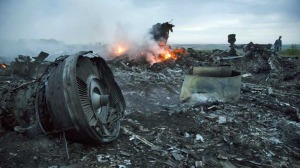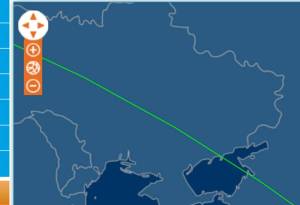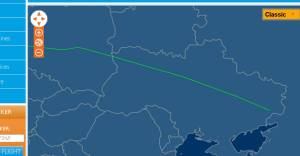There’s a rush to judgment about who shot down Malaysian Airlines Flight 17. That’s clearly dangerous with Ukraine a flashpoint in what appears to be turning into a new Cold War. Here are some things to think about as we try to separate fact from speculation and even outright fiction.

We share the horror and revulsion at the loss of 298 innocent lives in the downing of Malaysian Airlines Flight 17. And we believe It is imperative to ask inconvenient questions about a tragedy that has brought the world to the edge of a new and, indeed, very Cold War.
We also think everyone needs to become a smart news consumer. That means taking into account the history of disinformation foisted upon the public. It means recognizing that while our instinct is to accept stories where the “other” is the bad guy, things may be more complicated. And it means reminding ourselves of the military-industrial complex that Dwight Eisenhower warned us about—and how our “public servants” operate under constant pressure from wealthy interests with a stake in particular outcomes.
Surely as we look into the eyes of those who lost their lives, we know they would not want to be pawns in the cynical calculations of money and power. They would want the truth to come out, whatever it might be.

The shoot-down of MH17 must be viewed in the framework of a struggle that could affect the world’s power dynamic for years to come. Russia, China, India, Latin America and other players are cooperating more and more in ventures that have little room for the traditional domination by the U.S. Institutions like the World Bank are threatened by alternative bodies. The Western fossil-fuel establishment is facing increasing competition from state-run oil companies and others outside its usual spheres of influence.
And here is something even more dangerous: The U.S. military has been concerned about losing its ability to “project strength for U.S. interests” ever since the end of the Soviet Union sent the neocons in search of new “threats” to justify an ever-expanding U.S. military.
Without question, in the current international arena the downing of MH17 is a possible game changer. And game changers need to be rigorously examined.
Thus, while we allow for the very real possibility that the “authorized” version of the crash may prove true, we cannot ignore the larger picture—and the way in which this story has unfolded.
Rapid-Fire Conclusions
At WhoWhatWhy, we have a longstanding concern about the effectiveness with which the U.S. governments can quickly persuade Americans to rally around some simplistic narrative. From the Oklahoma City bombing to 9/11, our media and political establishments have failed to ask tough questions.
Within days of the Boston Marathon Bombings, we warned about a rush to judgment at a time when the authorities insisted they knew exactly what had happened, and that the investigation and questions about it should come to a halt. What gives us hope is that a significant minority, armed with memories of past fabrications and spin, refuse to simply accept what they are told. Perhaps that is why our first article on the bombings received more than 18,000 Facebook likes, quite a lot for a small site like ours.
With the MH17 crash, we were struck by the certainty with which U.S. and Western officials affixed blame, insisted that the plane had been brought down by a missile, and, moreover, asserted which “side” had fired it. Contrast that with TWA Flight 800 in 1996, where eyewitnesses stated they saw a projectile heading toward the plane before it exploded over Long Island. In that case, the government and media rushed to divert the public away from such claims—one of which implicated a U.S. Navy missile test gone awry.
(In an interesting sidelight to that continuing controversy, click here to watch CNN’s Anderson Cooper compare the MH17 incident to TWA 800, which he said had been “shot down”—Cooper returned shortly after to offer an apology for “misspeaking.”)
***
In all such events, the conclusions you draw depend largely on whom you listen to. When the State Department alleged that Russia was firing across the border into Ukraine, most Western media quoted U.S. officials without expressing any doubts. Predictably, the Russian network, RT, had a different take, citing one of the rare American journalists who refuses to simply parrot claims.
On its website, under the headline “State Dept. accuses Russia of firing artillery into Ukraine, refuses to provide any evidence,” RT wrote:
Matthew Lee, a veteran AP journalist known for his frequent showdowns with spokespeople during U.S. State Department briefings, raised questions about the latest claims during Thursday’s scheduled press conference.
“We have new evidence that the Russians intend to deliver heavier and more powerful rocket launchers to the separatist forces in Ukraine, and have evidence that Russia is firing artillery from within Russia to attack Ukrainian military positions,” State Department spokeswoman Marie Harf told reporters during the Thursday afternoon briefing.
When asked by Lee for any evidence, however, Harf said the State Dept. is unwilling at this time to disclose further details because doing so could expose the secret intelligence operations involved in making such claims.
“I would like to know what you’re basing this new evidence that the Russians intend to send any heavier equipment,” Lee asked.
The details, Harf responded, are “based on some intelligence information.”
“I can’t get into the sources and methods behind it,” Harf insisted to Lee’s chagrin. “I can’t tell you what the information is based on.”
Cui Bono: Who Benefits From the Current Situation?
We all know the official version about the Russian-backed separatists with the BUK missile system, who allegedly shot down the plane by mistake or simply because they were clumsy and drunk.
Yet the calls for sanctions ignore the possibility of an accident and imply a willful act. Which begs the question: What would Russia and its separatist proxies gain by blowing a passenger plane out of the sky? On balance, the downing seems a public relations disaster for Moscow.
It seems clear that in a situation and a place where several players are operating in secrecy under the proverbial “fog of war,” we need to be cautious about assigning blame. In such chaotic situations, many possibilities present themselves. They can range from an accident to a reckless, deliberate act by a few individuals operating without any sort of larger authority. There’s even the potential for an agent provocateur to launch a “false flag” attack, serving cynical interests that care nothing about the loss of innocent life when the stakes are high enough.
***
Provocations consisting of false horror stories are a favored arrow in the quiver of power. Look how effective it was to allege that Qaddafi and Assad ordered mass rapes. Those stories played big in the global media, though there is no reason to believe they were true, and plenty of reason to doubt.
And then there was the completely fabricated story by an American PR company that Saddam’s troops killed premature babies in Kuwait, which boosted public support for the first Gulf War under George H.W. Bush. This was topped by the false claim that Saddam was involved with 9/11, which in turn helped build support for the Iraq War under George W. Bush.
Yet when evidence points to the possible involvement of a U.S. ally (Saudi Arabia) and to the role of elements of the U.S. diplomatic and security establishment in, at minimum, covering things up regarding 9/11, there’s a near-total silence.
What’s going on here? Is it that we cannot bear to imagine that horrible things are being done, supposedly on our behalf, “to keep us safe”? Yet examples abound, from the My Lai massacre in Vietnam to the present-day assassination-by-drone of American citizens without due process—not to mention the slaughter of innocents by the U.S. or its proxies in any number of theaters of war including Iraq, Syria and Afghanistan, to name a few.
What’s at Stake—and Rarely Mentioned
The overt assigning of blame to Moscow in the MH17 downing comports with the general trajectory of recent news coverage of Russian President Vladimir Putin, which portrays him and anyone associated with him in a negative light. This serves a purpose in an ongoing high-stakes battle characterized by such dramatic developments as Russia’s providing haven to the whistleblower Edward Snowden, and Putin’s role thus far in blocking a Western plan to remove Syria’s Assad, thereby thwarting what had been a successful streak of “regime changes” in the Middle East (Saddam and Qaddafi).
Most important to understanding what’s at stake in Ukraine, however, is the struggle over natural resources.
News media—traditionally poor at providing context—failed to note that the tragic MH17 downing came amid an unfolding trade war between Washington and Moscow for the lucrative European natural gas market. Or that the sanctions are strengthening the American market potential in the area.
The battle over natural gas, oil and other fuels and minerals involves the entire European continent, in fascinating and intrigue-filled ways we recently described.
The first piece of evidence that sanctions against Russia may be more about oil and gas than about punishment is the surprising new restriction on the export of hi-tech oil-production equipment, and a total ban on equipment destined for deep water, Arctic, and shale oil production. Shale oil is of increasing importance to the United States, and the world.
Who are the Big Economic Losers?
According to an EU source familiar with the legal texts, the sanctions will cost the Russian economy €23 billion this year (1.5% of GDP) and €75 billion in 2015 (4.8% of GDP). The Economist meanwhile has calculated that Russian firms will suffer losses from the sanctions as high as $1 trillion (€744bn).
The sanctions will also weigh heavily on the economies of Western Europe: the EU commission forecasts that the European Union will lose €40 billion (0.3% of GDP) this year and €50bn in 2015 (0.4 % of GDP). That’s because Russia is expected to retaliate with trade bans of its own against EU countries, which are still largely dependent on Russian gas and have strong economic ties with Moscow and its Big Money. For example, London’s priciest real estate has long been dominated by Russian oligarchs.
With all these considerations, we would be foolish to view the plane tragedy in isolation.
Fascinating Discrepancies Raise Provocative Questions
–Was the person who shot down MH17 “a defector” from the Ukrainian army?
U.S. intelligence officials have suggested that the person who fired the missile that downed the plane may have been a “defector” (or defectors) from the Ukrainian army. This was an apparent attempt to explain why some CIA analysts thought satellite images revealed men in Ukrainian army uniforms manning the missile battery believed responsible for the shootdown. Of course, if the people firing on the plane can be identified with the Ukrainian army in any respect, they could also be….Ukrainian government soldiers.
–Could MH17 have been shot down by accident by the Ukrainian army, or the separatists?
The Russian news agency RIA Novosti—not to be trusted any more or less than any other major news organization—quoted a source as follows:
On July 17 the commanding officer of 156th Anti-Aircraft Regiment was instructed to conduct a training exercise of ground troops stationed near Donetsk, which involved deploying the troops, and carrying out a routine tracking and destroying of targets with the Buk-M1 missile.
In this scenario, Ukrainian troops, not rebels, accidentally fired off rockets when two Sukhoi Su-25 combat aircraft flew parallel to the Boeing 777—but at a different altitude. According to this version, when the three aircraft merged and became a single dot on the missile’s radar system, the Buk-M1 automatically chose the larger target, leading to the demise of MH17.
Another version, advanced by some U.S. intelligence officials, holds that the separatist rebels fired on the jet after misreading their radar, mistaking MH17 for a Ukrainian military plane.
An unidentified senior rebel leader admitted that a unit made up of Ukrainians and Russians fired the missile that downed the plane by accident, according to an Associated Press report. An AP reporter, and residents, witnessed a Buk missile launcher rolling through the town of Snizhne—about 10 miles from the crash site—on the same day MH17 went down. A soldier in unmarked camouflage, with a Russian accent, stopped to ensure the journalist was not taking photographs.
These plausible stories should be investigated before conclusions can be drawn.
–Was MH17 shot down after being escorted by Kiev fighters, as claimed by a Spanish air traffic controller?
Another version of the MH17 downing has been circulating on social media networks: the alleged Twitter posts of a Spanish air traffic controller named Carlos, described as working at the Boryspil International Airport in Kiev. In the series of July 17 tweets, translated from the original Spanish by an unknown person with a poor command of English, @spainbuca wrote:
“The B777 plane flew escorted by Ukraine jet fighter until 2 minutes before disappearing from the radar,” says an 11:48 tweet.
“Malaysia Airlines B777 plane just disappeared and Kiev military authority informed us of the downing, How they knew?” he asked at 12:00.
“7:00 minutes after [plane disappeared], the downing was notified, later our tower was taken with foreigner staff, they still here ” his next tweet said.
He blamed the Ukrainian government for shooting down the plane and trying to make it look like the work of pro-Russian separatists.
Some of his tweets suggest it may have been a military uprising against the current Ukrainian president by partisans of ex-Prime Minister Yulia Tymoshenko. Others describe soldiers, accompanied by foreigners, coming to the control tower to gather up all the evidence and coaching the controllers on what to say about the downing if asked.
Mysteriously, the Twitter account of the user was deleted the next day, and the man’s full identity has never been made clear. Here’s where it gets even more interesting: he appeared on RT’s Spanish-language channel in May, claiming he’d sent his wife and children home after being threatened by Euromaidan supporters. Euromaidan is a broad coalition of people behind this year’s revolution, many of whom are allied with Tymoshenko’s party.
This may turn out to be an unreliable story, or an outright hoax carried out as a propaganda operation. Either way, the story of Carlos is one that should be checked—and that is just what we’re doing.
A Change of Course—Right Over the Conflict Zone
Significantly, radar screen shots show MH17 executing an unexplained change of course. The altered flight path took the aircraft directly over the eastern Ukraine conflict region, in contrast to the previous day’s routing of the same flight. See for yourself:
July 16
July 17
(Source: flightaware.com)
Russian Claims and Questions
A high-ranking Russian military official claims that a Ukrainian military jet was flying close to MH17 before it was downed.Lieutenant-General Andrei Kartopolov told a press conference that the SU-25 attack jet was gaining height and came within 3-5 kilometers of MH17. Those jets, which are primarily used for ground attack, can briefly fly high enough to have reached the altitude of the MH17, and can be equipped with air-to-air missiles that can destroy flying targets, he said.
Russian officials say they have evidence of the jet’s presence following images taken by the Rostov monitoring center. The implication is that it might have been a Ukrainian military jet that shot down the Malaysian plane.
Kartopolov criticized the U.S. for not releasing its own satellite images taken at the time of the shoot-down, which the Russians say will confirm just which missile or missiles were launched by the rebels.
Further, the general asserted that Ukraine itself had BUK missile launchers located a few miles to the northwest of the Lugansk crash site on July 14, near rebel-held territory. He said that satellite images revealed the Ukrainian batteries in place on July 14, but absent from images taken on July 17, the day of the shoot-down.
The Russians have posed 10 questions about the tragedy, though few if any Western media outlets have even acknowledged them. Here they are:
[box]1. Immediately after the tragedy, the Ukrainian authorities, naturally, blamed it on the separatist forces. What are these accusations based on?
2. Can Kiev explain in detail how it uses Buk missile launchers in the conflict zone? And why were these systems deployed there in the first place, seeing as the self-defense forces don’t have any planes?
3. Why are the Ukrainian authorities not doing anything to set up an international commission?
4. Would the Ukrainian Armed Forces be willing to let international investigators see the inventory of their air-to-air and surface-to-air missiles, including those used in SAM launchers?
5. Will the international commission have access to tracking data from reliable sources regarding the movements of Ukrainian warplanes on the day of the tragedy?
6. Why did Ukrainian air traffic controllers allow the plane to deviate from the regular route to the north, towards “the anti-terrorist operation zone”?
7. Why was airspace over the warzone not closed for civilian flights, especially since the area was not entirely covered by radar navigation systems?
8. How can official Kiev comment on reports in the social media, allegedly by a Spanish air traffic controller who works in Ukraine, that there were two Ukrainian military planes flying alongside the Boeing 777 over Ukrainian territory?
9. Why did Ukraine’s Security Service start working with the recordings of communications between Ukrainian air traffic controllers and the Boeing crew and with the data storage systems from Ukrainian radars without waiting for international investigators?
10. What lessons has Ukraine learned from a similar incident in 2001, when a Russian Tu-154 crashed into the Black Sea? Back then, the Ukrainian authorities denied any involvement on the part of Ukraine’s Armed Forces until irrefutable evidence proved official Kiev to be guilty.[/box]
Anyone who wants to know what really happened in the MH17 tragedy needs to consider these theories and questions, and indeed, any legitimate questions from either side of the Ukrainian conflict.
Time and again, the world has seen open-ended wars erupt from fabricated or manipulated events. That potential exists today, in the fog of war that hangs ominously over an eastern Ukraine killing field.
[box] WhoWhatWhy plans to continue doing this kind of groundbreaking original reporting. You can count on us. Can we count on you? What we do is only possible with your support.
Please click here to donate; it’s tax deductible. And it packs a punch.[/box]




